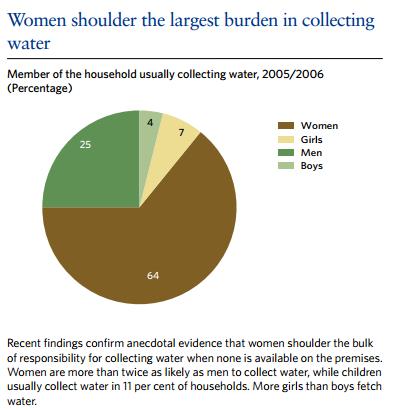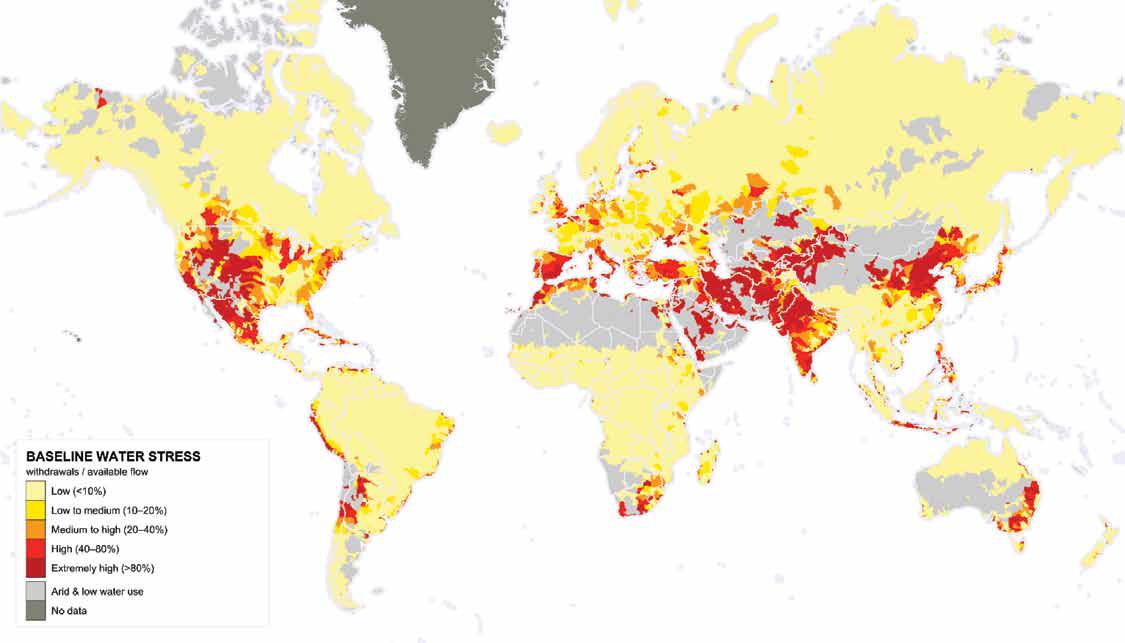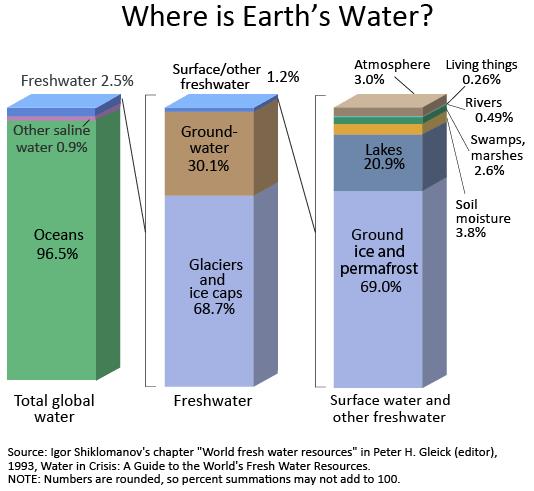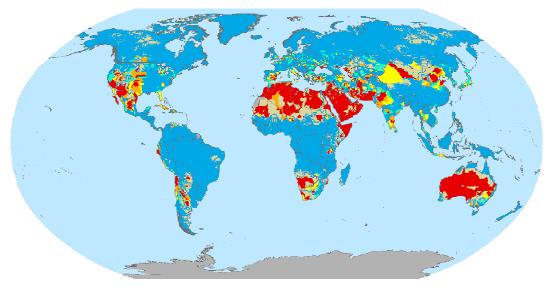Mission 2017: Global Water Security. We are a group of MIT students on a mission to ensure that all people in all nations have access to fresh, clean water.
What is Water Security?
Mission 2017 has defined water security as a peoples’ ability to maintain a constant and sufficient supply of safe, clean water without negatively impacting the people and environment around them.
To help visualize the current state of water security in the world, we have prepared an interactive map showing many of the factors that contribute to or relate to water security.
Filter By:
Interested in our data? Get it here.
The Importance of Water
Water lies at the heart of everything that is important to human life. We drink it. We use it to grow our food, to clean ourselves, to flush wastewater, and to generate electricity. Water infrastructure has been essential to the development of human civilization throughout history. Wells have been discovered in Northern Israel dating back to 8500 BP [3]. Much later, in industrial London, the cholera death rate remained above 20 per 1000 deaths until local governments implemented an adequate central water system that improved the general state of hygiene in the city [4].
Water is an even more important resource today. The World Economic Forum has declared that “water is an astonishingly complex and subtle force in an economy. It is the single constraint on the expansion of every city, and bankers and corporate executives have cited it as the only natural limit to economic growth.” [7].
According to the United Nations, “In 2011, 768 million people were still without access to improved sources of drinking water while 2.5 billion people did not use improved sanitation” [2]. The UN defines the baseline need for clean water access as 20 to 50 liters of water per day to ensure that people’s needs for drinking, cooking, and cleaning are met.
But what does this mean? More than 3.4 million people die each year from water, sanitation, and hygiene-related diseases. 99 percent of these deaths occur in the developing world, and 90 percent are children under the age of five [2]. And because there is a shift towards urban slums in developing countries, this situation isn’t likely to improve without an active international effort [2].
Who is Affected?
The majority of water-insecure populations live in developing countries [2]. Specifically, physical water shortage exists in North Africa, the Middle East, India, Central Asia, China, Chile, and South Africa [5]. Sub-Saharan Africa is one of the hardest hit regions in terms of water related development problems. Countries in this region spend on average 12 percent of their health budgets treating diarrhea, a water borne disease [8]. Also, on a typical day more than half of hospitalized patients in these countries suffer from fecal (water borne) diseases [8].
Figure 1: Women bear the largest burden of collecting water in developing countries [9].
Women and children are the most affected by lack of water security (see figure 1). They spend hours every day walking miles to the nearest source of water, which is often unsafe to drink [5]. This is time that they could be spending on tasks critical to development, such as education, work, and caring for their families. If a community has a clean source of water women in that community will have free time to pursue new opportunities, and the children will have time to go to school.
Additionally, human society is intricately connected to the environment, and our consumption of water is no exception. Water pollution, eutrophication, hypoxia, and wetland loss are all ways that humans can harm to the environment [8]. But humans can do good for the environment as well. We can recycle and clean water, we can recharge aquifers, and we can preserve freshwater ecosystems.
Figure 2: Areas of the world experiencing the greatest water stress [12]
The Source of Water
About 70 percent of the surface of the earth is covered by water [5]. Most of this is ocean water, which is not very useful in its saline state. About 2.5 percent of all the water on earth is freshwater; or about 34.5 million cubic kilometers. Much of this is inaccessible, being trapped in the ice caps, and so the total amount of usable fresh water on the earth as estimated by the UN is 200,000 cubic kilometers.
Figure 3: Breakdown of earth’s freshwater reserves [6]
How do we use water?
There are several ways that people use water. Most organizations divide them up into three sectors: domestic use, agricultural use, and industrial use. Worldwide, agriculture accounts for 70% of all water consumption, compared to 20% for industry and 10% for domestic use [2]. Certain crops are more water intensive than others. To help visualize which crops require the most water, we have prepared an interactive chart displaying the water footprint of 15 common crops.
Domestic water distribution usually involves a water supply network and water management system. These water supply networks are either centralized or local. Usually, water supply networks in developed countries are centralized, and are local in less developed countries. In these undeveloped countries, water infrastructure or the lack thereof directly influences the local economy, the standard of living, life expectancy, and even seemingly unrelated issues like gender equality. But there is hope for a bright future. Access to safe drinking water has been improving in recent decades. In 1970, only 30 percent of people in developing countries had access to safe drinking water. By 2004, this number had risen to 79 percent, and if the world continues to invest in improved sanitation this trend is expected to continue [9]. This is a smart investment, and not just because it will improve people’s lives. According to the United Nations Educational, Scientific and Cultural Organization (UNESCO), every $1 invested in improved water supply and sanitation can yield from $4 to $12 for the local economy.
A Changing Future
The two most pressing concerns for the future of water security are population growth and climate change. The world population is expected to reach 9.6 billion by the year 2050, and more than half of this growth is expected to occur in Africa [10]. This will strain current water distribution systems and available water resources. Additionally, if nothing is done to correct the unsustainable rate at which aquifers are being depleted certain aquifers, such as the Ogallala, will run dry in as little as 50 years (see figure 4). This is a human health concern, it is an environmental problem, and it is a political problem. For this reason, water allocation will become a very important issue in the future [8]. The correct solution is to find a balance between how much water is needed by people and how much should be reserved for the preservation of freshwater ecosystems.
Figure 4: Projected future water stress on world aquifers (greater stress in red) [12]
The problem is, the future amount of water that will be available for allocation is difficult to predict because global climate change has the potential to greatly alter the hydrologic cycle, especially for developing countries in Central Asia, Africa, and Latin America where the water deficit is projected to increase as much as 50 percent [8]. This is why we, Mission 2017, have committed to solving the problem of preserving our most precious resource: water.
In order to illustrate how water stress might change, Mission 2017 has prepared an interactive map showing certain metrics which may contribute to water stress in the future.
Filter by:
Interested in our data? Get it here.
Our Solution
Mission 2017 has created this website to present our solutions to the individual problems of global water security, and has prepared a step-by-step implementation guideline for any country facing water security challenges. To be more specific, however, we are proposing implementation guidelines for creating and improving water infrastructure in developing nations. We are also recommending sustainable water use and integrative water management solutions in developed nations.
Modeling: The Cost of Inaction
To understand what will happen if the world doesn’t act on this issue, Mission 2017 has developed a model that predicts the expected change in water demand by 2030 for every country. The model predicts both the total change in water demand and the change by sector.
** Reference in this site to any specific commercial product, process, or service, or the use of any trade, firm or corporation name is for the information and convenience of the public, and does not constitute endorsement, recommendation, or favoring by MIT. **
References
1. Prüss-Üstün, Annette; Bos, Robert; Gore, Fiona; Bartram, Jamie. (2008). Safer Water, Better Health. World Health Organization. Retrieved from http://water.org/water-crisis/water-facts/water/
2. (2012). Statistics: Graphs and Maps. UN Water. Retrieved from http://www.unwater.org/statistics_pollu.html
3. Ashkenazi, Eli. (November 9, 2012). Ancient well reveals secrets of first Jezreel Valley farmers. Israel News. Retrieved from http://www.haaretz.com/news/national/ancient-well-reveals-secrets-of-first-jezreel-valley-farmers-1.476288
4. Brown, Robert W. (March 16, 2004). London in the Nineteenth Century. University of North Carolina at Pembroke. Retrieved from http://www.uncp.edu/home/rwb/london_19c.html
5. (2007). Water in a Changing World. UN Water. Retrieved from http://www.unesco.org/new/fileadmin/MULTIMEDIA/HQ/SC/pdf/WWDR3_Facts_and_Figures.pdf
6. Perlman, Howard. (November 5, 2013). How much water is there on, in, and above the earth. The USGS Water Science School. Retrieved from http://ga.water.usgs.gov/edu/earthhowmuch.html
7. (2012). Water. World Economic Forum. Retrieved from http://www.weforum.org/issues/water
8. (2013). Water and Climate Change. The World Bank. Retrieved from http://water.worldbank.org/topics/water-resources-management/water-and-climate-change
9. (2008). The Millennium Development Goals Report 2008. United Nations. Retrieved from http://mdgs.un.org/unsd/mdg/Resources/Static/Products/Progress2008/MDG_Report_2008_En.pdf
10. (June 13, 2013). World population projected to reach 9.6 billion by 2050. UN Department of Economic and Social Affairs. Retrieved from https://www.un.org/en/development/desa/news/population/un-report-world-population-projected-to-reach-9-6-billion-by-2050.html
11. Brown, Lester. (November 21, 2013). Aquifer Depletion. Encyclopedia of Earth. Retrieved from http://www.eoearth.org/view/article/150159/
12. Gassert, Francis, et. al. (January 2013). Aqueduct Metadata Document. World Resources Institute. Retrieved from http://www.wri.org/publication/aqueduct-global-maps-20




